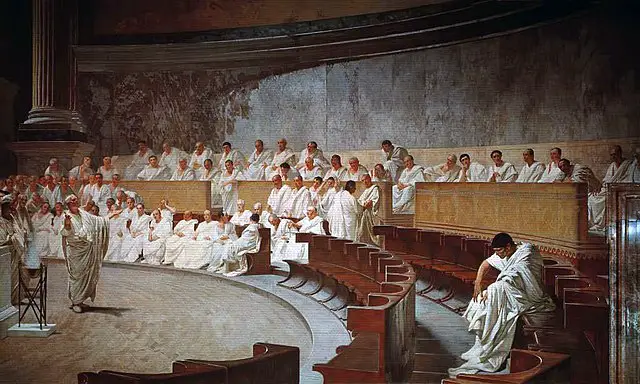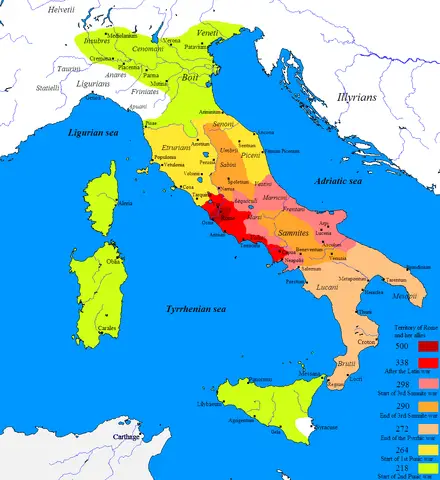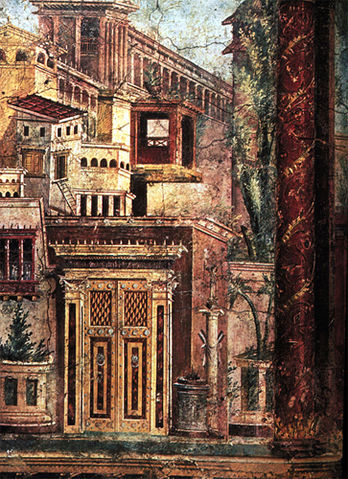
| Further Reading | The Roman Republic vs. Athenian Democracy: Comparisons |
Could Rome have survived under the Republic instead of transitioning into the Roman Empire in the 1st century AD? History professors often get this question in their classes as they lecture about the Roman Republic and the answer is generally the same.
Generally speaking, yes Rome would have survived as a Republic. The laws and customs the Republic had in place would have continued to propel Rome into the 1st and 2nd centuries AD. However, without the centralized bureaucracy of the Empire, a 1st-century Republic would have had tremendous difficulty expanding and becoming as grand as it did under the early Roman Empire.
When people think about Roman history they imagine gladiators, large marble sculptures, massive buildings, and an imperial city that seemed to defy the decay of time. However, this was not always the case. Much of what we would call ‘Roman’ came about after the fall of the Republic because of the centralized power that monarchies in antiquity provided. To put it simply, the buildings of the Republic of Rome were made of wood while the buildings of the Roman Empire were made of marble.
Here at The History Ace, I strive to publish the best history articles on the internet. If at the end of this article you enjoyed it then consider subscribing to the free newsletter and sharing it around the web.
Without further ado, here is an entire article answering the question of whether or not Rome would have survived as a republic instead of an empire.
Rome Surviving As The Republic In The 1st And 2nd Century

Yes, the Roman Republic could have survived well into the first and second centuries AD. However, the Rome that we know of today from history would have looked completely different.
The reason that the Roman Republic could have continued to survive well into the 1st and 2nd centuries AD was that Rome had little military competition at this time. We have the foresight of time and one of the main reasons why the Roman Empire was able to expand so fast and easily was because they held a monopoly on military power in the Mediterranean region.
As such the Roman Republic would have had little pressure from outside the provinces of Rome. If Caesar never crossed the Rubicon, along with a myriad of other problems, then life would have continued as usual in the Republic. Consuls would have been the rulers of Rome for one year and then go on to extract excess wealth out of a province as a pro-consul.
However, there are two major problems with this timeline. The first is the question of feeding an exploding population in the city of Rome and the second is the problem of defending the borders of provinces later on.
Republican Rome Attempting To Feed Its Growing Population In The 1st Century
While Rome had almost 0 real threats from outside kingdoms the real threat was the expanding population of the city itself. It is estimated that the average population of the city of Rome during the early Republic was between 600,000-800,000. This population would have had to be fed, housed, and most important pacified because they held a vote.
The Roman Empire would simply give grain from Egypt to the people to pacify them, this was called the Grain Dole and it was a way for the Roman Emperor keeping the masses happy. The problem with the question of the continuation of the Roman Republic into the 1st and 2nd centuries is the question of preventing widespread famine and civil war.
The problem is that each province was held under the control of a senator or senatorial family. Let’s say you were in charge of the Roman province of Egypt where the grain came from. You essentially controlled the grain supply of the city of Rome. Your colleagues would ask for free grain for the people and you would be placed in a hard situation to either give it away for free or ask for something in return.
On top of this throw in the problem of corruption that comes from a government having many offices instead of one. Now you have political factions arguing over the shipments of grain while the Roman people starve. Could it have worked out? Yes. Would it have been an easy problem to solve? No.
Republican Rome Attempting To Defend Its Provinces And Enfranchisement Of Newly Conquered People
Now let’s talk about another major problem the Republic faced. The concept of rapid deployment of legions to defend borders and enfranchisement of new voters into the voting pool of the Republic.
During the 2nd century BC the Roman Republic entered into a series of wars that drastically cut back on the male population of Rome. On top of this only men with property could afford to buy the equipment necessary to become a Roman soldiers. With war after war in the 2nd century AD Rome found itself struggling to fill the ranks of the Roman military. This entire time the territory was expanding.
In 107 BC Gaius Marius addressed these pitfalls of the Roman Republic and instituted reforms across the Roman Military. Now any Roman male could join the legion even if they did not hold property. Further, the Roman general was in charge of paying for troops and providing for their general wellbeing. What this created were private armies that were loyal to the individual general instead of the Republic.
For a while, Roman generals were happy with dismissing their soldiers and being bestowed with honors by the Roman Senate. However, some generals decided that it was a better career move for them to simply take their private army and march on Rome itself.
Let’s assume that Caesar never did this. How would a Republican Rome in the 1st and 2nd century AD prevent this from happening? As you can see this would present a major hurdle that would need to be addressed immediately or else another Caesar would simply create an empire.
Further, with each expansion of territory, there would be more people that would enter the Roman ‘system.’ Not all of them would gain the ability to vote, but with the success of the Social War in 87 BC, it would undoubtedly lead to pressure from Romanised people to become enfranchised. As you might imagine this would also be a massive problem that the Roman Republic would have to contend with if Rome was to survive as a republic and not an empire.
What Would The Roman Republic Of The 1st and 2nd Century AD Look Like

Let’s assume that Rome survived as a Republic well into the 1st and 2nd centuries. What would this city look like?
Rome would look completely different if the Empire never existed. This is because of 3 major reasons. First, under the Roman Empire wealth became centralized with allowed for massive building campaigns. Second, to bolster the new government artists were commissioned to create propaganda. Third, it is doubtful that a 1st and 2nd century AD Roman Republic would have expanded as far as the Empire.
It is important to remember that there are a lot of ‘what ifs’ in this scenario. While we can never be certain what the Roman Republic of the 1st and 2nd centuries would have looked like here is the best-case scenario.
Rome’s Wealth Would Not Have Been Streamlined As A Republic Meaning No Large Buildings
While there were many bad things that happened out of the Roman Republic transitioning to the Empire the centralization of wealth was not one of them. During the Roman Republic, much of the wealth of Rome was centralized around the elite Senetorial Families who would have their own members serve as pro-consul and take excess tax from their assigned province. A Roman Emperor began to centralize all of the wealth under their own faction and as such the resources of Rome became much more centralized.
This centralization of Roman wealth and resources is what allowed the early to middle Roman Empire to build such massive buildings. These are buildings such as the Pantheon, Colosseum, and the multiple bath complexes around the city. Further, the centralization of wealth under the Emperor allowed Rome to invest its resources more efficiently leading to a large surplus mining operation taking place in northern Spain and other provinces.
As such, in this fake scenario of the Roman Republic surviving into the 1st and 2nd centuries AD, there would be little in the way of public spending. The elite senatorial families of Rome simply did not need to spend to convince the Roman population of their right to rule over the Republic.
There Would Be No Commissioned Latin Writers To Push Out Augustan Propaganda
The first emperor of Rome, Augustus, had to cement his rule after being named the princips (“first citizen”) of Rome. One of the best ways to do this was to commission writers and artists to create art that supported the fledgling regime.
Augustus was a master at crafting an image that served to convince the average Roman that he was like them while also demonstrating his authority to rule over the Roman people. Famous writers such as Livy, Horace, Virgil, and Ovid all compiled their now famous works under the careful gaze of Augustus.
In a world where the Roman Republic survived into the 1st and 2nd centuries AD, there would have been no need to create the stories that the great Latin writers did. This would have been because the elite senatorial families of Rome would not have needed to use writers to convince the Roman people of their greatness.
This goes for nearly all the art commissioned during the Augustan golden age of Latin Authors. Painters, writers, sculptors, travelers, etc. a majority of it would have more than likely not have been as popular or survived up to our present day.
During The 1st And 2nd Century AD The Roman Republic Would Not Have Expanded As Far As The Empire
One of the major drawbacks of the Roman Republic was the reliance of the military on the financial situation of each general. Under the Empire, each legionary was loyal to the Emperor for their paycheck and future security.
In a world where the Roman Republic survived into the 1st and 2nd centuries AD, the expansion of Roman territory under Augustus and other emperors simply would not have taken place. This is because for a variety of reasons but the largest would be that each general would have to seek the approval of the Roman Senate to march against another state or territory.
Because of internal politics and the general time, it would take to get approval Roman generals under the Republic were faced with a hard choice of either using their army to secure their own aims or the aims of the Roman Republic. It would be doubtful that each general in this Roman Republic would have acted in the best interests of the Roman Republic.
Simply put, without the central bureaucracy system that the Empire had it is doubtful that the Republic would have expanded as far as it did under the Empire.
Conclusion
There you have it; an entire article going over the question of whether or not Rome would have survived as the Roman Republic instead of the Roman Empire.
The study of Roman history is a fascinating subject of research. We still understand very little about their civilization and why they did some of the things they did. If you are willing to learn Latin and some ancient Greek then you could easily spend a career writing about the Roman Republic’s interaction with the Greek city-states.
Here at The History Ace, I strive to publish the best history articles on the internet. If you enjoyed this article then consider subscribing to the free newsletter and sharing it around the web.
Further, you can check out some of the other articles below.
-
How The American Revolution Changed The World

Here is how the American Revolution changed the world. Many people are not aware of just how important this event actually was.
-
Why The Roman People Loved Chariot Racing

Why did the Roman people love chariot racing? Well it all comes down to these 3 reasons.
-
The Design and Color of Roman Chariots

What was the design and color of Roman Chariots? Were they faster or slower then normal chariots? Well here is everything!